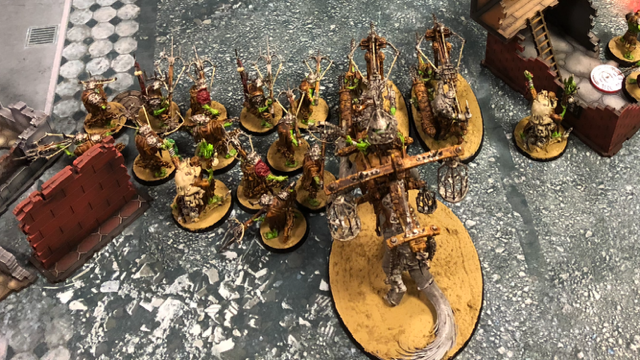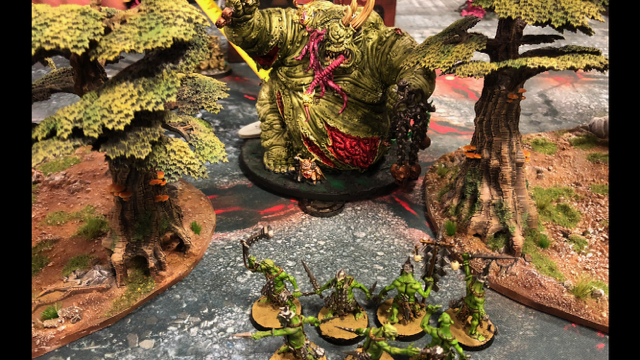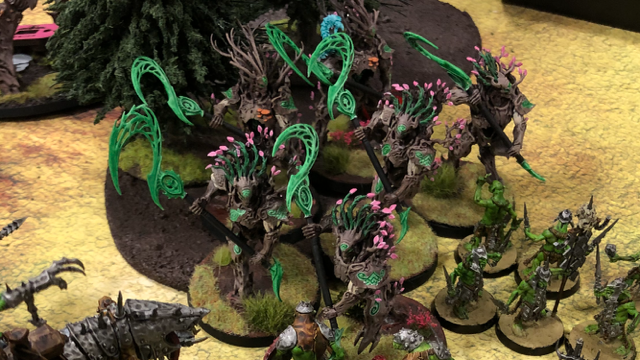Last weekend my local store held it’s first AoS tournament. A friend from my gaming group had been working extremely hard to get the AoS scene off the ground, and he was going to be the TO for the event. When he sent me the information about the event my initial thoughts were, “why in the world would I go to a tournament where the turn order isn’t even set?!”. My friend persevered through my skepticism, and I agreed to come to event with my Kruleboyz. Two hectic weeks of painting Orruks almost every night after work, and just 4 practice games of AoS later, I was at my very first AoS tournament. I was completely wrong in all my thoughts about how uncompetitive this game is, the level of strategic complexity and the level of balance I would find at an AoS tournament.
The Dreaded Double Turn:
One of the biggest turn offs for me, and a lot of other people, when they look at AoS is the double turn mechanic. What do you mean we just roll off at the start of each Battle Round to see who gets first turn?! Can’t that mean some people get steamrolled pretty hard?! It turns out the double turn mechanic was one of the most exciting parts about all of my games. In my first matchup I was playing a Seraphon player who smartly kept his big monsters back out of Boltboy range until the later turns of the game. My opponent was crashing into my gunline (boltline?) with his big scary monsters, and all hope seemed lost for my Orruks. Except it wasn’t. Even with 3 big monsters running down my Orruks, all I needed to get a win was to roll the double turn. Two chances of shooting at my opponent’s army would get me right back into winning the game. Unfortunately the priority roll did not work out in my favor and I lost my first game of the day. Even though I lost, without the double turn mechanic, I would have stopped enjoying that game about halfway through when I realized I had nothing to play for. With the chance to go twice in a row though I always had some hope!
The double turn mechanic can absolutely create feels bad moments on the tabletop. It is something that really needs to be planned for and accounted for when playing a game of AoS. The better players that I have seen always keep the double turn mechanic in mind when moving their models, and sometimes players will give away the double turn in order to get the chance at it the next round, or to destroy and Objective.
Always Something To Do:
Part of the reason I still had an awesome time throughout my losses was always feeling like I had a chance to get back into the game if I could get a clutch double turn, but also a huge part of it was the interactivity of AoS. When first looking at the AoS rules some players may think it is a more simplistic game than 40k because the rules are much lighter, there are no army specific Stratagems and AoS doesn’t require 300 pages of books to be carried around in order to run an army. Throughout the entire tournament I found that having just a few Command Points per turn, that could only be spent in very specific ways, made the planning and execution of your army’s strategy on the table incredibly in-depth.
I always asked myself if spending my Command Points on an All Out Attack was going to be worth it knowing I was going to want those CP later in order to help with the squishiness of my army by using things like All Out Defense or Hold The Line. One of my “learning moments” came in my first game when I redeployed a unit of Boltboyz to within 15 inches of a unit of Salamanders. I used All Out Attack on them, but I failed to kill the unit of Salamanders. I didn’t properly plan my CP usage and when my opponent charged the Boltboyz I was unable to use Unleash Hell. My mistake on budgeting my CP felt extremely impactful to the game since, unlike in 40k, there are only so many CP you have access to per turn in AoS (and its not 10 like in 40k).
My favorite part of AoS was the interaction there is available even if it is your opponent’s turn. There were a couple times during the tournament where a solid roll on Redeploy blocked enemy units from getting to Objectives, or an Unleash Hell put out so many wounds my opponent’s charge was blunted. I always felt engaged in the game no matter how bad it was going. There was always something I could be doing, and in a tabletop game that’s important!
Know Your Foe:
I learned, the hard way, that it is extremely important to know what your opponent’s army is capable of in AoS. This is also true in 40k, but it felt more important in AoS. In 40k I can walk up to the tournament table without ever playing against GSC and my opponent can tell me “oh I can deepstrike real good”. I know what deep striking is, I know what units of my opponent’s will be deepstriking, and I can generally plan to play against it not knowing too much about the faction. In my third game I played a Sylvaneth player who absolutely destroyed my poor Orruks because I had no idea what his army was capable of. My opponent told me about his armies ability to teleport with his trees, but I went into the game with the 40k mindset of “some of his stuff is going to teleport toward me, meh”.
AoS seemed much more dialed up to 11 than 40k. My Kruleboyz can SHOOT. Don’t come within 27 inches of my Boltboyz castle unless you wanna feel the sting of a ton of mortal wounds. My third game opponent’s army teleported, like all of it teleported, I needed to have a plan to deal with his entire army right from the start of the game. I felt like these extremes in army rules really helped make the game on the tabletop easier to play and plan for tactically.
Even though I finished at a low scoring 1-2 leaving me down at the bottom of the tournament standings I had a fantastic time during all of my games, and all of my opponents were awesome people. If you are getting tired of the 40k meta right now, where there are some matchups some armies just cannot win, take a look at AoS. I am not saying this is the most balanced tabletop wargame available, but it was a ton of fun!






